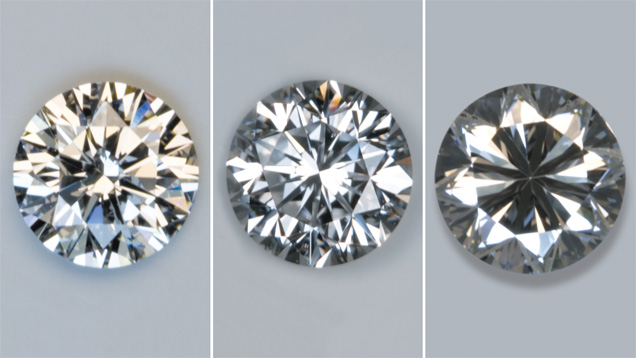
If you’ve ever wondered why your diamond looks different in sunlight versus candlelight or daylight versus office lights, it’s because the cut of your diamond responds differently depending on the light and the environment you are in. How – and where – you look at your diamond can greatly change its appearance.
Al Gilbertson, a GIA researcher, says if you think of a diamond like “a series of mirrors reflecting its environment,” it can help you understand how light and location can change the way your diamond appears. When you look at your diamond, you are also seeing a reflection of the surrounding environment, including yourself.
“Often times, the dark parts of the pattern you see in a diamond are a reflection of your face, or the camera – if you’re looking at a photograph,” Gilbertson says. “You can test this yourself. Hold the diamond at arm’s length and look at how bright it is and how the pattern of dark and light appears. Now, gradually bring it closer to your eye. By the time it gets very close, the area of dark pattern in the diamond has grown and is much more prominent.”
“This all means that in every different location you look at your diamond, this ‘series of mirrors’ is reflecting not only the environment, but also you. How close you hold it, and the environment you are in, affects the pattern you see.”
When it comes to the 4Cs of GIA’s Diamond Grading System – color, clarity, cut and carat weight – cut is often the least understood because there are so many components considered in the cut grade. The first three – brightness, fire and scintillation – describe the diamond’s appearance. The remaining four components – weight ratio, durability, polish and symmetry – describe the design and craftsmanship.
Each cut grade – excellent, very good, good, fair and poor – represents a range of proportion sets and diamond appearances. There is no single set that defines a well-cut round brilliant diamond – many different proportions can produce attractive diamonds, which should be bright, fiery, sparkling and have a pleasing overall appearance, especially when the pattern of bright and dark areas is viewed face up, Gilbertson says.
GIA’s Diamond Cut Grading System for standard round brilliant diamonds in the D-to-Z color scale and the Flawless-to-I3 clarity range provides an objective assessment of a diamond’s overall cut quality.
GIA studied diamond cut for decades and analyzed tens of thousands of proportion sets before the system was introduced in 2005. It had to be scientific, but also practical and applicable to the jewelry industry and public. There were more than 70,000 observations of 2,300 diamonds in studies conducted across all sectors of the jewelry industry – diamond manufacturers, dealers, retailers and potential customers.
Diamonds graded in GIA’s laboratories are examined in standardized and calibrated environments – scales for carat weight, optical measuring equipment for all of the diamond’s proportions, light for color grading and 10X loupes for clarity, polish and symmetry help ensure consistency and objective grading.
Most people won’t ever see the diamond in a laboratory, so what type of lighting is best when purchasing a diamond? Gilbertson encourages you to look at the diamond in the type of lighting you will most typically wear it.
GIA’s Cut Grade System offers a description based on research and what most people prefer. But Gilbertson likes to remind people that diamonds are more than that.
“Diamonds and jewelry are very personal,” he says. “People buy jewelry for themselves or receive it as a gift for a specific reason, often to celebrate a special occasion. Choose what you like and what looks best in your opinion. Then, enjoy the adventure of learning all the different appearances your diamond can have.”
Note : The above story is based on materials provided by Gemological Institute of America Inc. The original article was written by Kristin A. Aldridge .










